Plants with Yellow or Orange Flowers
Plants with yellow or orange flowers are a pretty diverse bunch, but there are some key families that contain a large number of the species. The daisy family is a good place to start as it contains some large groups, such as the dandelions and allies. Other important groups include the st. John's-worts, buttercups, brassicas and trefoils.
As well as flower colour, it is important to take careful note of the exact petal shape - are the petals rounded, or do they came to a sharp point, for example; are there gaps between the petals or do they overlap; are the flowers solitary, or arranged in spikes or bunches.
Within the colour sections, the pictures are grouped so that similar-looking (though not necessarily closely-related) plants will be near each other.
This should help to reduce your search time. To keep things concise, not all species are shown in the colour keys, so you may have to go for a 'best match' to get you through to the next stage of the identification process. Particularly in large families where there are a number of very similar species, a representative species is shown here, but clicking on it will take you to a page that tells you how to tell the more difficult species apart.
Many plants will be obviously one colour or another, obviously five petalled, or obviously a woody shrub, etcetera. But many will be debatable. In such cases, I have tried to imagine how a flower might be perceived by others, especially beginners to plant identification. Generally this results in a plant appearing in more than one place on these pages, but some still remain problematic. In particular, the section labelled 'tubular flowers' contains a variety of flowers that might be considered to fall into that category and these generally have petals that are fused together to fully surround the sexual parts of the flower. But these tubes might be elongate like a pencil, or broad and bell-like. Flowers of two colours are entered under the colour that covers most of the flower, but truly bicoloured flowers may be entered under both colours. Woody plants with green stems that might not be considered woody, are entered under their flower colour or shape, as well as under the woody plants sections.
If you still can't find your plant, you either have something very interesting that you may wish to tell me about, or I just haven't got a picture
of it yet - I'm still working on the latter!!
Click on the pictures below to go to the species pages.
 |
 |
 |
 |
Meadow-rues - Fine, open heads of many petalless flowers, which may appear yellow due to the relatively large, dangling stamens
|
Daisy Family - Greenish-yellow 'cones' on low plants with feathery foliage
|
Daisy Family - Yellow discs like small buttons on low plants
|
Bur-marigolds - Yellow 'buttons' on weedy plants, often in wetlands
|
 |
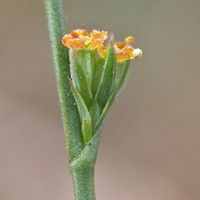 |
 |
 |
Daisy Family - Tight, yellow clusters of flowers with a tubular base
|
Umbellifers - Tiny clusters of orange-tinged flowers on delicate stems; hard to spot in grassy places
|
Ragweeds - Open heads of tightly clustered flowers above deeply cut leaves
|
Groundsels - Tight, yellow clusters of flowers with a tubular base on small annual plants
|
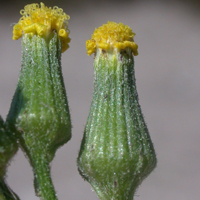 |
Groundsels - Tight, yellow clusters of flowers with a tubular base on small annual plants
|
 |
Hypecoums - Actually four petals, but two very small! Low, prostrate pants with feathery foliage
|
 |
 |
Irises - Three large, rounded petals hanging down, plus three smaller, less obvious petals standing upright in the centre
|
Irises - Three large, rounded petals hanging down, plus three smaller, less obvious petals standing upright in the centre
|
 |
 |
 |
 |
Poppies - Broadly overlapping, flimsy petals
|
Poppies - Broadly overlapping, flimsy petals
|
Poppies - Broadly overlapping, flimsy petals
|
Evening-primroses - Flowers atop upright stems with willow-like leaves; petals often large and floppy
|
 |
 |
Iceland Poppy - Broadly overlapping, flimsy petals in white, cream, yellow or orange
|
Hypecoums - Two large petals and two very small. Low, prostrate pants with feathery foliage
|
 |
 |
 |
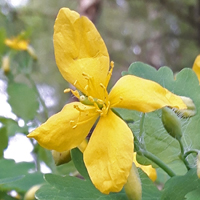 |
Tormentils - Low, scrambling or trailing plants in grassy places
|
Wallflowers - Variously yellow, orange or reddish flowers
|
Cabbage Family - Pale creamy-yellow flowers with darker veins
|
Greater Celandine - Few flowers in an open hdead; plant has bright yellow-orange, POISONOUS sap
|
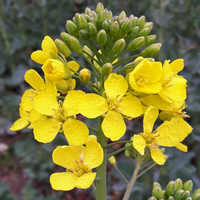 |
 |
 |
 |
Cabbage Family - Flowers in tight heads, elongating as the seed pods develop below
|
Small Alison - Tiny plants with flowers in tight, hairy clusters. Very rare
|
Crosswort - Greenish-yellow flowers in whorls up the stem
|
Bedstraws - Open 'frothy' heads of small flowers on low-growing plants
|
 |
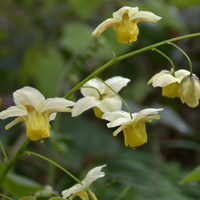 |
 |
 |
Golden-saxifrages - No petals, but four, yellow sepals, in flat heads atop rounded, fleshy leaves; shady streamsides and similar wet places
|
Barrenworts - Complex flowers, appearing as if four-petalled, in graceful, open spikes. Low plants forming spreading patches
|
Cabbage Family - Petals very narrow, upright; flowers clustered in loose heads and followed by long seed pods
|
Evening-primroses - Flowers atop upright stems with willow-like leaves; petals often large and floppy
|
 |
 |
 |
 |
Nasturtiums - Trailing or climbing plants with circular leaves
|
Hollyhocks - Large, round flowers in a very tall spike
|
Common Rock-rose - Low-growing plant in sunny, grassy places. Flowers with many stamens
|
Meadow-foam - Flowers yellow and white like poached eggs
|
 |
 |
 |
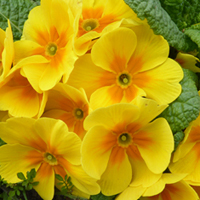 |
Water-primroses - Plants forming spreading mats of vegetation beside waterways and floating on the water surface
|
Prickly Mallow - Weak-growing annuals of disturbed ground with simple leaves
|
Golden-saxifrages - Tiny flowers in open heads with yellow, leafy bracts and slightly succulent leaves
|
Primroses - Early spring flowers in wooded and grassy areas
|
 |
 |
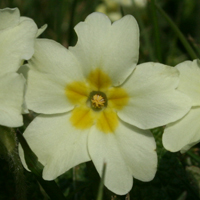 |
 |
Buttercups - Brilliant yellow flowers often in abundance in grassy places
|
Creeping-Jenny - Creeping plants with flowers on short stalks
|
Primroses - Early spring flowers in wooded and grassy areas
|
Mulleins - Pale yellow flowers with prominent, furry stamens
|
 |
 |
 |
 |
Marsh St John's-wort - Low, creeping plant in wet bogs. Rare
|
Gourds & Cucumbers - Large, floppy flowers on trailing or climbing plants
|
Kerria - Twiggy bushes with thin, green, wiry stems
|
Monkeyflowers - Flowers tubular at the base, opening to showy, five-petalled mouths
|
 |
 |
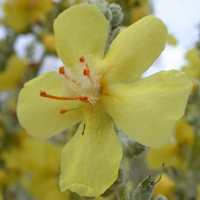 |
 |
Loosestrifes - Flowers in upright spikes and often with orange centres
|
Common Purslane - Tiny flowers on succulent, creeping plants
|
Mulleins - Pale yellow flowers with prominent, furry stamens
|
Cinquefoils - Petals notched at tip; low, creeping plants with three- or five-parted leaves
|
 |
 |
 |
 |
Wood Avens - Flowers in branched spikes followed by barbed seedheads
|
Hybrid Avens - Solitary or small clusters of flowers on nodding stems followed by barbed seedheads
|
Common Rue - Evergreen bushes with highly aromatic, blue-green foliage
|
Common Henbane - Dull yellow flowers with dark purple veins on clammy-hairy plants
|
 |
 |
 |
 |
Yellow Pimpernel - Creeping plants with flowers on long stalks
|
Fringed Water-lily - Flowers resemble small water-lilies; growing in ponds
|
St John's-worts - Petals and sepals usually with black dots; leaves often with translucent dots (hold up to light)
|
Tutsans - Groundcover plants or thin, bushy plants with more or less evergreen leaves
|
 |
 |
 |
 |
Velvetleaf - Upright plants with heart-shaped, very velvety leaves
|
Mexican Marigolds - Small annuals with pinnate leaves and a cluster of tiny, petalless flowers clustered at the centre of a compound flower
|
Mexican Marigolds - Small annuals with pinnate leaves and a cluster of tiny, petalless flowers clustered at the centre of a compound flower
|
Cucumber family - Solitary flowers on stocky trailing or climbing plants with large leaves
|
 |
 |
 |
 |
Spearworts - Slightly fleshy-leaved plants of wet places
|
Yellow-sorrels - Low, creeping plants with trifoliate leaves; mostly in urban habitats
|
Buttercups - Flowers with small, sometimes poorly-formed petals and swollen green centres
|
Beggarticks & Allies - Broadly strap-shaped petals around a clusterd head of many, petalless flowers
|
 |
 |
 |
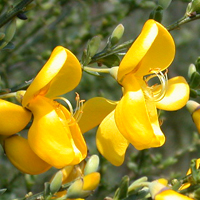 |
Fiddlenecks - Flowers in a coiled spike, which unfurls as the flowers open
|
Gromwells - Pale yellow flowers with a tubular base
|
Stonecrops - Flowers in heads with long, obvious stamens, above very fleshy leaves
|
Brooms & Gorses - Broad petals, the upper one the largest, the lower two fused to form a boat-shaped 'keel'
|
 |
 |
 |
 |
Vetches & Trefoils - Broad petals, the upper one the largest, the lower two fused to form a boat-shaped 'keel'
|
Pansies - Various mixes of yellow, white and purple flowers, with dark lines near the centre
|
Cucumber family - Large and floppy, solitary flowers on stocky trailing or climbing plants with large leaves
|
Cucumber family - Large and floppy, solitary flowers on stocky trailing or climbing plants with large leaves
|
 |
Lady's-mantles - Tiny, greenish-yellow flowers, massed in frothy heads above palmate leaves
|
 |
 |
 |
 |
Montbretia - Spikes of brilliant orange flowers above grass-like leaves
|
Orange Day-lily - Flowers on long stems, above strap-like leaves
|
Yellow-eyed-grasses - Very low plant with grass-like leaves
|
Yellow
Star-of-Bethlehem - Small, star-like flowers; rare in ancient woodland
|
 |
 |
Bog Asphodel - Spikes of brilliant yellow flowers with prominent, hairy stamens, growing in acid bogs
|
Yellow Garlic - Rounded heads of six-petalled flowers, on upright stalks
|
 |
 |
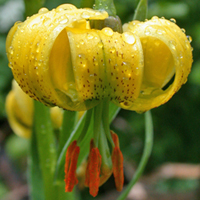 |
 |
Water-primroses - Plants forming spreading mats of vegetation beside waterways and floating on the water surface
|
Lilies - Clusters of orange or yellow flowers, marked with dark streaks
|
Lilies - Flowers with strongly recurved petals, at the top of an upright, leafy stem
|
Tulips - Spring flowering from bulbs, flowers in a wide range of colours, single atop a slender stem
|
 |
 |
 |
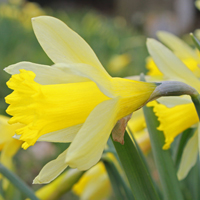 |
Winter Aconite - Six petal-like sepals, surrounded beneath by a ruff of green, frilly bracts; late winter or very early spring
|
Tulips - Bright and showy spring flowers, arising from bulbs
|
Crocuses - Flowers fused into a narrow tube at the base; narrow leaves with a white stripe
|
Daffodils - Six free petals with a tubular centre. Flowers come in many shades of yellow and orange
|
 |
 |
 |
Irises - Three large, rounded petals hanging down, plus three smaller, less obvious petals standing upright in the centre
|
Irises - Three large, rounded petals hanging down, plus three smaller, less obvious petals standing upright in the centre
|
Gladioli - Broad-petalled flowers arranged in a vertical spike
|
 |
 |
 |
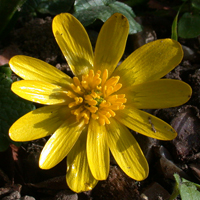 |
Yellow-wort - Eight-petalled flowers atop stems with perfoliate leaves
|
Lesser Celandine - Eight to twelve petals on low plant, forming spreading mats; woods, roadsides and grassy places
|
Lesser Celandine - Eight to twelve petals on low plant, forming spreading mats; woods, roadsides and grassy places
|
Lesser Celandine - Eight to twelve petals on low plant, forming spreading mats; woods, roadsides and grassy places
|
 |
 |
 |
 |
Daisy family - Strap-like petals with a contrastingly dark centre
|
Daisy family - Showy heads made up of many-petalled flowers
|
Daisy family - Flower head made up of a ring of strap-like petals with petalless flowers in the centre
|
Yellow-eyed-grasses - Long spikes of pale yellow flowers with grass-like leaves
|
 |
 |
 |
 |
Water-lilies - Large, neatly rounded flowers growing in water
|
Poppies - Varying number of very broadly overlapping petals
|
Daffodils - Six free petals with a mass of twisted petals in the centre. Flowers come in many shades of yellow and orange
|
Kerria - Twiggy bushes with thin, green, wiry stems
|
 |
 |
 |
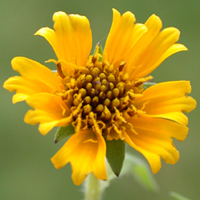 |
Hollyhocks - Pompom flowers in a very tall spike
|
Rose-moss - Pompom flowers on creeping plants with succulent, needle-like leaves
|
Aster Family - Heads of bright orange, dandelion-like flowers on walls or in lawns
|
Niger - Daisy-like flowers with eight broad petals
|
 |
 |
 |
 |
Mexican Marigolds - Small annuals with pinnate leaves and a relatively large, pompom head of yellow or orange flowers with many petals
|
Mexican Marigolds - Small annuals with pinnate leaves and a compound, pompom head of yellow or orange flowers with many petals
|
Mexican Marigolds - Small annuals with pinnate leaves and a compound, pompom head of yellow or orange flowers with many petals
|
Groundsels - Tight, yellow clusters of flowers with a tubular base and small, strap-like petals that are often curved back
|
 |
 |
 |
 |
Goldenrods - Small flowers packed together into large clusters on upright stems, often forming spreading colonies
|
Lettuces & Allies - Small flowers packed together into large clusters on upright stems
|
Water-lilies - Large, many-petalled flowers growing in water among floating leaves
|
Tricolour Chrysanthemum - Showy daisy flowers with bands of different colours on the petals and deeply cut leaves
|
 |
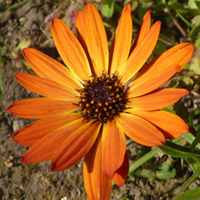 |
Garden Dahlia - Showy daisy flowers with ornamental petals and pinnate, coarsely-toothed leaves
|
Cape Daisy Hybrids - Large, showy flowers, the petals with darker undersides
|
 |
 |
 |
 |
Daisy family - Strap-like petals around the outside with a cluster of petalless flowers in the centre
|
Daisy family - Strap-like petals around the outside with a cluster of petalless flowers in the centre
|
Daisy family - Strap-like petals around the outside with a cluster of petalless flowers in the centre
|
Dewplants - Creeping plants with fleshy leaves and large flowers
|
 |
 |
 |
 |
Tricolour Chrysanthemum - Showy daisy flowers with bands of different colours on the petals and deeply cut leaves
|
Yellow Knapweeds - Tight flowerheads with solid bases and 'fluffy' tops
|
Yellow Thistles - Thistle-like flowers that are yellow or creamy yellow in colour
|
Safflowers - Tight flowerheads with solid bases and 'fluffy' tops, on prickly plants
|
 |
 |
 |
 |
Yellow Skunk-cabbage - Strange yellow hood in spring, before leaves. Grows in swampy ground
|
Birthworts - Clusters of flowers in the leaf axils
|
Foxgloves - Narrow, tubular flowers, arranged in a tall spike
|
Crocuses - Six petals free at the top but fused into a narrow tube at the base
|
 |
 |
 |
 |
Balsams - Delicate, hanging flowers with long nectar spur at back
|
Balsams - Delicate, hanging flowers with long nectar spur at back
|
Marvel-of-Peru - Flowers of yellow, orange, pink or red with narrow, tubular base, opening at night
|
Common Cowslip - Narrow flowers in a cluster atop a single stem
|
 |
 |
 |
 |
Monkeyflowers - Flowers tubular at the base, opening to showy, five-petalled mouths
|
Snapdragons - Tubular flowers with broadened lips forming a two-lobed 'mouth', on trailing plants; rare
|
Germanders - Flowers tubular at the base, opening to a large, rounded lower lip, but no upper lip to the flower, leaving the stamens exposed
|
Toadflaxes - Narrow flowers with long spurs at the back, in upright spikes
|
 |
 |
 |
 |
Yellow Figwort - Flowers rounded like small bladders; petals small and hard to count
|
Dead-nettle family - Flowers with a tubular base, opening to broadly five-lipped mouths
|
Dead-nettle family - Flowers with a tubular base, opening to broadly five-lipped mouths
|
Broomrape family - Flowers with a tubular base, opening to a broad-lipped mouth
|
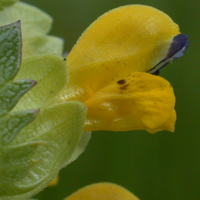 |
 |
 |
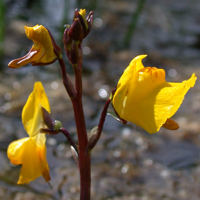 |
Broomrape family - Flowers with a tubular base, opening to a narrow, two-lipped mouth
|
Broomrape family - Flowers narrowly tubular, opening to a narrow mout
|
Yellow Corydalis - Flowers on succulent stems above ferny foliage; usually growing from walls
|
Bladderworts - Broadly tubular flowers with a two-lobed mouth; in short spikes emerging from water
|
 |
 |
 |
 |
Comfreys - Bunches of hanging flowers with large, roughly hairy leaves
|
Daisy family - Tight, yellow clusters of flowers with a tubular base
|
Groundsels - Tight, yellow clusters of flowers with a tubular base
|
Cudweed allies - Tight, yellow clusters of flowers with a tubular base and papery phyllaries
|
 |
 |
 |
 |
Yellow Bird's-nest - Almost colourless plants with no leaves and flowers clustered at the top of a short stem
|
Red-hot-pokers - Flowers densely packed in upright spikes; orange, turning to yellow when mature
|
New Zealand Flaxes - Flowers with protruding stamens, carried in clusters on tall, branching spikes above long, sword-shaped leaves
|
Tulips - Spring flowering from bulbs, flowers single atop a slender stem
|
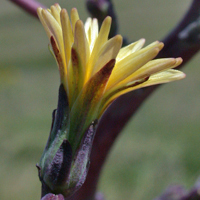 |
 |
Daisy family - Tight, yellow clusters of flowers with a tubular base
|
Hybrid Petunia - Large, showy flowers with thin, floppy petals fused together into a tube at the base
|
 |
 |
 |
 |
Foxgloves - Narrow, tubular flowers, arranged in a tall spike
|
Cape Figworts - Narrow, tubular flowers, arranged in a one-sided spike on woody-based plants
|
Yellow Garlic - Rounded heads of six-petalled flowers, on upright stalks
|
Tufted Loosestrife - A rare introduction of damp ground; flowers with five, very narrow petals and flowers tightly bunched in the leaf axils
|
 |
 |
 |
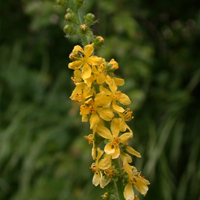 |
Montbretia - Spikes of brilliant orange flowers above grass-like leaves
|
Daffodils - Six free petals with a tubular centre. Flowers come in many shades of yellow and orange
|
Yellow-eyed-grasses - Long spikes of pale yellow flowers with Sword-like leaves
|
Agrimonies - Long spikes of five-petalled flowers, followed by bristly seedheads
|
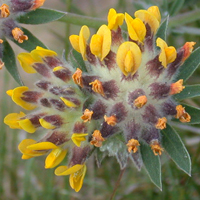 |
 |
 |
 |
Common Kidney Vetch - Tight, very hairy heads of narrow, tubular, 'pea' flowers
|
Yellow Corydalis - Flowers on succulent stems above ferny foliage; usually growing from walls
|
Trefoils - Small, dense heads of 'hooded' flowers above trifoliate leaves. Small annuals of disturbed ground
|
Meadow-rues - Fine, open heads of petalless flowers, which may appear yellow due to the relatively large, dangling stamens
|
 |
 |
 |
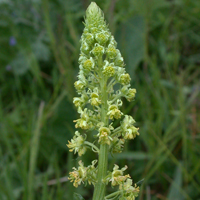 |
Hollyhocks - Large, round flowers in a very tall spike
|
Alisons - Large heads of golden yellow, four-petalled flowers on low plants
|
Crosswort - Greenish-yellow flowers in whorls up the stem
|
Mignonettes - Upright spikes of delicate flowers with four narrow petals
|
 |
 |
 |
 |
Rhubarbs - Huge, spreading flowerhead of tiny, creamy flowers above massive, crinkled leaves
|
Scabiouses - Tight heads of many cream-coloured flowers, with the outer flowers having larger petals
|
Tansies - Flat heads of many, button-like, petalless flowers
|
Mulleins - Single or branched spikes of showy, five-petalled flowers with prominent, furry stamens
|
 |
 |
 |
 |
Umbellifers - Flat heads of small flowers on radiating stalks
|
Daisy family - Showy heads made up of many-petalled flowers
|
Sages - Tubular flowers in circular heads, older plants woody at the base
|
Cudweed allies - Tight, yellow clusters of flowers with a tubular base and papery phyllaries
|
 |
 |
 |
 |
Red-hot-pokers - Flowers densely packed in upright spikes; orange, turning to yellow when mature
|
Goldenrods - Small flowers packed together into large clusters on upright stems, often forming spreading colonies
|
Goldenrods - Small flowers packed together into large clusters on upright stems, often forming spreading colonies
|
Spurges - Strange, greenish-yellow flowers in large, clustered heads at the tips of the branches
|
 |
Lady's-mantles - Tiny, greenish-yellow flowers, massed in frothy heads above palmate leaves
|
 |
 |
 |
 |
American Tulip-tree - Large, greenish-yellow and orange flowers on large trees in early summer, rare in parks and amenity sites
|
St John's-worts - Long-stamened flowers on rounded, leafy bushes
|
Kerria - Twiggy bushes with thin, green, wiry stems
|
Winter Jasmine - Bright flowers on bare, angular, green stems during the colder months
|
 |
 |
 |
 |
Forsythias - Masses of four-petalled flowers crowding the stems before the leaves in spring
|
Kerria - Twiggy bushes with thin, green, wiry stems
|
Sages - Tubular flowers in circular heads, older plants woody at the base
|
Cornelian-cherry - Small, four-petalled flowers in tight clusters on bare branches during the winter
|
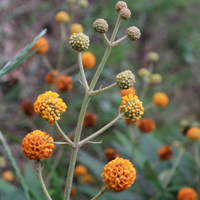 |
 |
 |
 |
Butterfly-bushes - Flowers in tight balls on opposite-paired stalks
|
Butterfly-bushes - Flowers in tight balls, strung together in longer spikes
|
Cape Figworts - Narrow, tubular flowers, arranged in a one-sided spike on woody-based plants
|
Chilean Glory-flower - Brilliant orange flowers on a tangled, scrambling climber
|
 |
 |
 |
 |
Laburnums - Hanging bunches of flowers on trees with trifoliate leaves
|
Tree Lupin - Upright spikes of 'pea' flowers on bushes with fingered leaves; mostly coastal
|
Brooms & Gorses - Broad petals, the upper one the largest, the lower two fused to form a boat-shaped 'keel', on wiry, green-stemmed plants, or very spiny bushes
|
Azaleas - Showy, five-petalled flowers on multistemmed bushes
|
 |
 |
 |
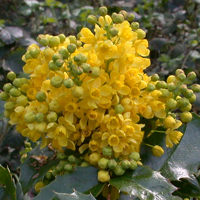 |
Honeysuckles - Small, bell-shaped flowers, hidden beneath branches of evergreen leaves
|
Barberries - Hanging bunches of five-petalled flowers on spiny bushes
|
Barberries - Hanging bunches of five-petalled flowers on spiny, evergreen bushes
|
Oregon-grapes - Tight bunches of flowers above shiny, leathery leaves with prickly margins
|
 |
 |
 |
 |
Maples - Showy bunches of bright yellow flowers, opening just before the leaves
|
Maples - Showy, hanging bunches of pale yellow flowers, opening with the leaves
|
Cornelian-cherry - Rounded clusters of yellow flowers, opening before the leaves in late Winter or early Spring
|
Currants - Bunches of bright flowers with a clove scent
|
 |
 |
 |
 |
Wireplant - Small bunches of cream-coloured or off-white flowers on blackish, wiry, climbing or rambling stems
|
Bog Myrtle - Stiff, greenish-yellow flower clusters atop twiggy bushes; all parts of plant heavily scented; in wet areas
|
Hazels, birches and alders - Flowers in dangling 'lamb's tails' in winter or early spring
|
Willows - Upright, fluffy 'catkins'
|
 |
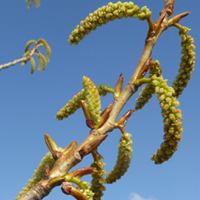 |
 |
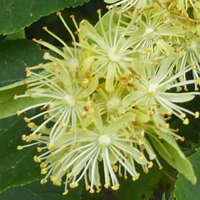 |
Willows & Osiers - Petalless flowers densely packed into upright spikes, opening in spring
|
Poplars - Petalless flowers densely packed into hanging spikes or catkins, opening in spring
|
Sweet Chestnut - Petalless flowers densely packed into stiff, radiating spikes or catkins, opening in summer
|
Limes - Green-petallesd flowers in loose clusters, hanging beneath a curved, leaf-like bract
|
 |
 |
 |
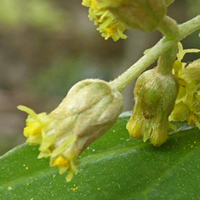 |
Palms - Exotic, evergreen trees with large, fan-like or pinnate leaves
|
Orange-peel Clematis - Vigorous, tangled climbers with solitary, four-petalled flowers
|
Shrubby Cinquefoil - A dense-branched, low shrub, the hairy leaves with five leaflets
|
Ake-Ake - Evergreen bushes with tough, leathery leaves which are thickly felted with white hairs beneath
|
 |
 |
Pride-of-India - Ornamental trees with pinnate leaves and flowers in large panicles followed by dry, inflated fruits
|
Small-leaved Azara - Clusters of petalless flowers in the axils of small, evergreen leaves
|